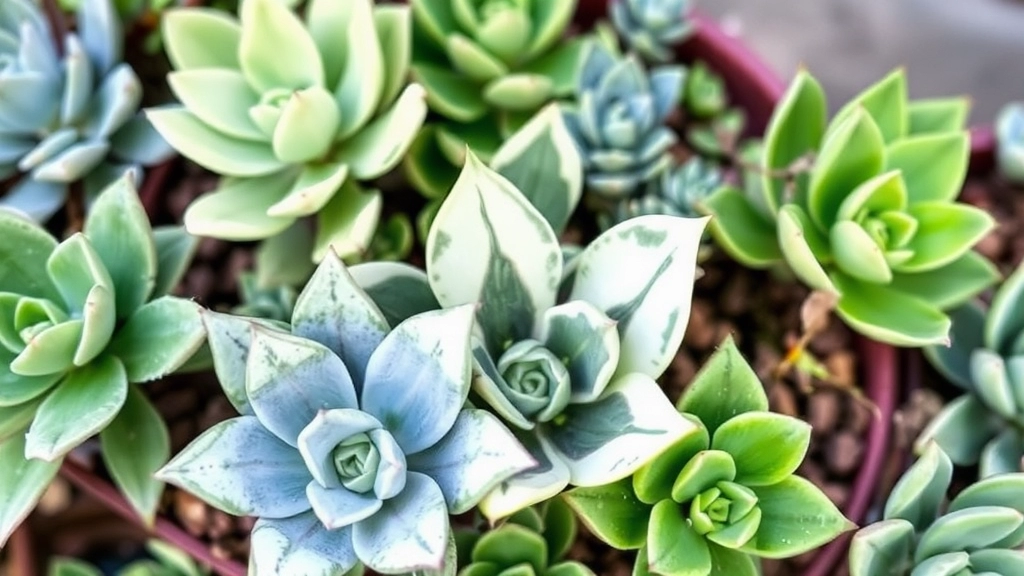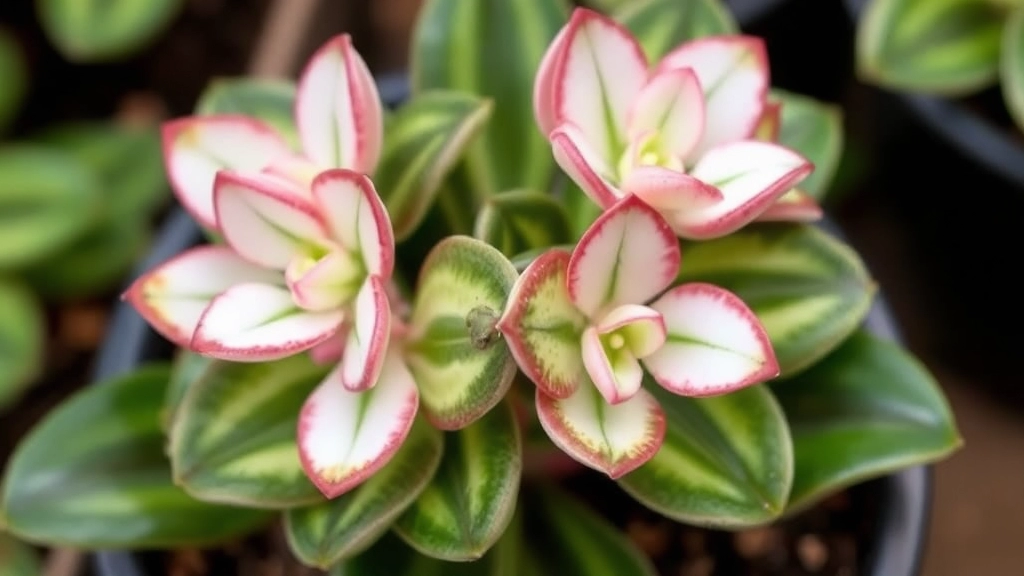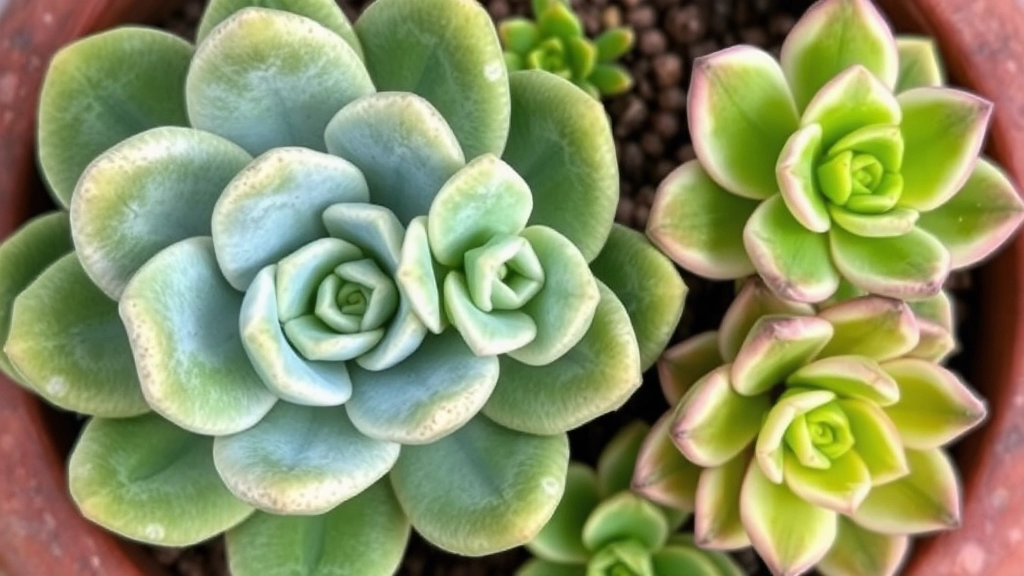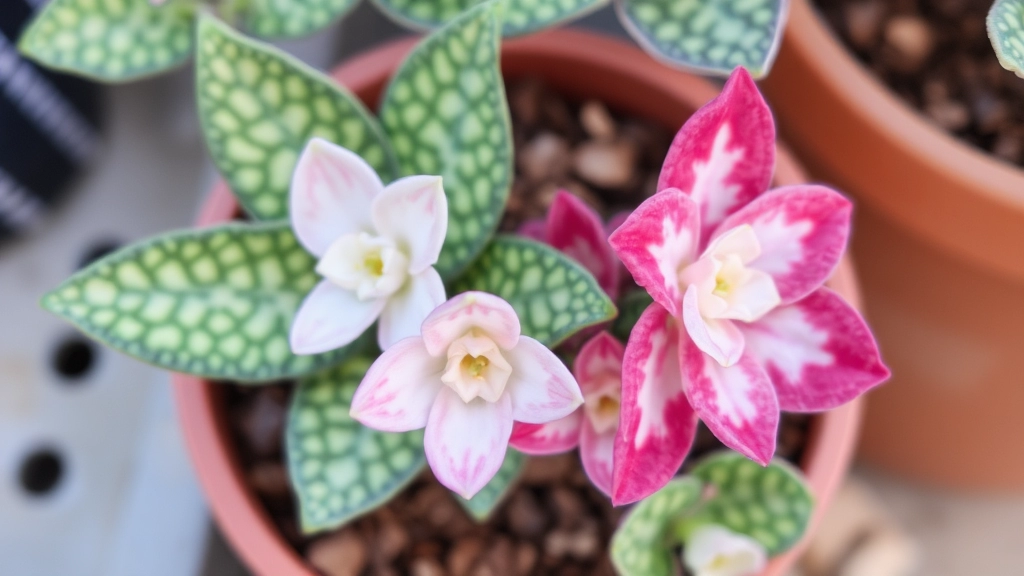Discovering the Kalanchoe Beharensis Variegata
Discovering the Kalanchoe Beharensis Variegata is like finding a gem in the world of succulents. This rare variety stands out with its distinctive yellow to gold striations on thick, pelted leaves. Whether you’re a seasoned collector or a newbie, understanding its unique features can help you appreciate and care for this beauty.
Incorporating Kalanchoe Beharensis Variegata
Incorporating the Kalanchoe Beharensis Variegata into your garden or home requires some know-how. From optimal growing conditions to proper watering and light needs, this plant demands a bit of attention. But trust me, the effort is worth it. Let’s dive into how you can make this variegated succulent thrive and where you might find it online.
Unique Features of Kalanchoe Beharensis Variegata
When it comes to unique succulents, Kalanchoe Beharensis Variegata stands out for several reasons.
This plant, often referred to as the “Mother of Thousands,” boasts striking variegated leaves that can elevate any indoor or outdoor space.
Best Growing Conditions for Variegated Succulents

So, you’ve got your eye on Kalanchoe Beharensis Variegata, and you’re wondering what the best growing conditions are for these stunning succulents.
Let’s dive right in!
Light Requirements
First off, light is your best friend. Variegated succulents thrive in bright, indirect sunlight.
- Direct Sunlight: Too much can scorch those beautiful leaves.
- Low Light: Not enough light can lead to leggy growth and dull colours.
Aim for around 6 hours of bright light daily. A south or west-facing window is usually perfect.
Temperature and Humidity
Next up, temperature. Kalanchoe Beharensis Variegata loves a warm environment.
- Ideal Temperature: Between 20°C to 30°C (68°F to 86°F).
- Cold Sensitivity: They don’t like temperatures below 10°C (50°F), so keep them indoors during chilly months.
As for humidity, they prefer a dry atmosphere. This makes them perfect for indoor settings where humidity levels are lower.
Soil Type
Now, let’s talk about soil. You want a well-draining mix to keep those roots happy.
- Cactus Mix: A pre-made cactus or succulent mix works wonders.
- DIY Option: You can also mix regular potting soil with sand or perlite for better drainage.
Pot Selection
Choosing the right pot is crucial.
- Drainage Holes: Always pick pots with drainage holes to prevent root rot.
- Material: Terracotta is a great choice as it allows for airflow and helps wick away excess moisture.
Fertilization
Finally, let’s not forget about feeding.
- Growing Season: During spring and summer, a diluted succulent fertilizer every few weeks is ideal.
- Dormant Season: Cut back in the fall and winter when the plant is resting.
Watering and Light Needs of Kalanchoe Beharensis Variegata
When it comes to caring for Kalanchoe Beharensis Variegata, understanding its watering and light requirements is crucial for maintaining its vibrant appearance.
Watering Needs
One of the most common concerns for succulent enthusiasts is how often to water their plants. For Kalanchoe Beharensis Variegata, the key is to mimic its natural habitat.
- Frequency: Water every 2-3 weeks during the growing season (spring and summer).
- Soil Check: Always check the top inch of soil; if it feels dry, it’s time to water.
- Drainage: Ensure your pot has good drainage to prevent root rot.
- Signs of Overwatering: Yellowing leaves or mushy stems indicate too much water.
Light Requirements
Light is equally essential for the health of your Kalanchoe Beharensis Variegata. This succulent thrives in bright, indirect sunlight.
- Ideal Position: Place it near a south or west-facing window.
- Direct Sunlight: While it can tolerate some direct sunlight, too much can scorch the leaves.
- Low Light: Avoid placing it in low-light areas; this can lead to leggy growth and loss of variegation.
By providing the right balance of water and light, your Kalanchoe Beharensis Variegata will flourish, showcasing its unique variegated leaves. For more detailed care instructions, you can refer to the expert tips for healthy growth of Kalanchoe Beharensis. Additionally, if you are interested in learning about the care and propagation of its close relative, the Elephant Ear Kalanchoe Beharensis, check out our detailed guide.
Propagation Techniques for Variegated Kalanchoe

Are you eager to expand your collection of Kalanchoe Beharensis Variegata? Propagating this stunning succulent can be both rewarding and straightforward. Let’s delve into some effective techniques to help you successfully propagate your variegated Kalanchoe.
Leaf Cuttings
One of the most common methods for propagation is through leaf cuttings. Here’s how to do it:
- Select a Healthy Leaf: Choose a plump, healthy leaf from the parent plant.
- Cut the Leaf: Using a clean, sharp knife, cut the leaf at the base.
- Let it Callous: Place the leaf on a dry surface for a few days to allow the cut end to callous over. This prevents rot when planted.
- Plant the Leaf: Once calloused, place the leaf in well-draining soil, burying the cut end slightly.
- Water Sparingly: Mist the soil lightly and place it in a bright, indirect light area.
Offsets
Kalanchoe Beharensis often produces offsets, or “pups,” that can be separated for propagation. Here’s the process:
- Identify Offsets: Look for small plants growing at the base of the parent.
- Gently Remove: Carefully detach the offsets, ensuring you include some roots.
- Callous if Needed: If the offsets have been damaged, allow them to callous for a day or two.
- Plant in Soil: Place the offsets in a suitable potting mix and water lightly.
Seed Propagation
Though less common, propagating from seeds can be an exciting challenge. Here’s how to go about it:
- Collect Seeds: If your plant flowers, collect the seeds once they are dry.
- Prepare Soil: Use a light, well-draining soil mix.
- Sow Seeds: Scatter seeds on the surface and lightly press them into the soil.
- Moisture Control: Keep the soil moist but not soggy, using a spray bottle for gentle watering.
- Provide Light: Place in a warm, bright area, ensuring they receive indirect sunlight.
By employing these propagation techniques, you can easily multiply your Kalanchoe Beharensis Variegata. Each method offers a unique approach, allowing you to choose what suits you best.
As we delve deeper into caring for your Kalanchoe Beharensis Variegata, it’s essential to address the potential threats that could jeopardize its health.
**Common Pests**
Kalanchoe Beharensis Variegata, like many succulent plants, can fall victim to a few pesky pests. Here are the most common ones to watch out for:
– **Mealybugs**: These small, cotton-like insects suck sap from your plant, leading to yellowing leaves and stunted growth.
– **Aphids**: Tiny and often green or black, aphids can cause leaf distortion and may transmit diseases.
– **Spider Mites**: These microscopic pests thrive in dry conditions, causing speckled leaves and webbing on the plant.
– **Scale Insects**: These appear as small, brown bumps on the stems and leaves, robbing your plant of vital nutrients.
**Common Diseases**
In addition to pests, Kalanchoe Beharensis Variegata can be susceptible to various diseases:
– **Root Rot**: Often caused by overwatering, this disease leads to mushy roots and can quickly kill your plant if not addressed.
– **Leaf Spot**: Fungal infections may cause dark spots on the leaves, often resulting from poor air circulation or excessive moisture.
**Prevention and Treatment**
To keep your Kalanchoe Beharensis Variegata thriving, consider these preventive measures:
– **Regular Inspection**: Check your plants weekly for any signs of pests or disease. Early detection is key.
– **Proper Watering**: Ensure the soil dries out between waterings to prevent root rot.
– **Good Air Circulation**: Position your plant in a spot with adequate airflow to minimize fungal infections.
– **Natural Remedies**: For pests, consider using neem oil or insecticidal soap as a gentle treatment option.
By staying vigilant and implementing these strategies, you can protect your beloved Kalanchoe Beharensis Variegata from common threats. For more in-depth care tips, you might find the [care and propagation of Kalanchoe Beharensis Tree](https://planthq.org/care-and-propagation-of-kalanchoe-beharensis-tree/) useful. Additionally, if you are interested in other varieties, check out the [different types of Kalanchoe Tomentosa](https://planthq.org/types-of-kalanchoe-tomentosa-varieties-and-care-tips/).
How to Find and Purchase Rare Variegated Succulents Online

So, you’re keen on adding some rare variegated succulents, like Kalanchoe Beharensis Variegata, to your collection. But where do you even start looking?
Finding these unique plants online can feel a bit overwhelming. Trust me, I’ve been there.
Here’s how to make your search smoother:
1. Know Your Sources
- Specialty Nurseries: Look for online nurseries that focus on succulents.
- Etsy and eBay: Great platforms for finding rare plants from individual sellers.
- Facebook Groups: Join succulent enthusiast groups where members often sell or trade plants.
2. Search Smart
- Use specific keywords like “Kalanchoe Beharensis Variegata” or “rare variegated succulents.”
- Don’t forget to check for synonyms or related terms like “variegated succulents for sale.”
3. Check Reviews
- Before making a purchase, read through customer reviews and ratings.
- Look for sellers with a history of happy customers to avoid any nasty surprises.
4. Watch for Quality
- Request photos of the actual plant before buying.
- Ensure the seller is transparent about their plant care practices.
5. Know the Price Range
- Rare succulents can vary in price. Do a little research to understand what’s reasonable.
- Be wary of prices that seem too good to be true; they often are.
6. Shipping Considerations
- Check the seller’s shipping policies.
- Make sure they package plants properly to avoid damage during transit.
Finding rare variegated succulents online doesn’t have to be a chore. With a little research and some savvy searching, you’ll be adding stunning plants to your collection in no time.
When it comes to showcasing your Kalanchoe Beharensis Variegata, the right display can elevate its unique beauty and charm. You might be wondering how to create an eye-catching arrangement that draws attention while ensuring the plant thrives.
### Choosing the Right Location
– **Light Conditions**: Place your Kalanchoe in a spot that receives bright, indirect sunlight. Avoid harsh, direct light to prevent leaf burn.
– **Temperature**: Keep it in a warm environment, ideally between 20-25°C, as this succulent prefers mild conditions.
### Container Selection
– **Drainage**: Opt for pots with drainage holes to prevent water accumulation. Terracotta or ceramic pots work well.
– **Size**: Choose a container that allows for growth; a slightly larger pot can accommodate future expansion.
### Arrangement Ideas
– **Group Planting**: Combine Kalanchoe Beharensis Variegata with other succulents for a stunning display. Varieties with contrasting colours and shapes can create a vibrant arrangement.
– **Vertical Gardens**: Consider vertical planters or wall-mounted displays to save space and create a focal point.
### Seasonal Considerations
– **Indoor Display**: During colder months, bring your plant indoors to protect it from frost. For more detailed care tips, you might find this [complete care guide for Kalanchoe Beharensis](https://planthq.org/complete-care-guide-for-kalanchoe-beharensis-felt-plant/) useful.
– **Outdoor Arrangements**: In warmer seasons, place your Kalanchoe in a sunny outdoor area but ensure it’s sheltered from heavy rain.
### Maintenance Visibility
– **Regular Grooming**: Keep the leaves clean and remove any dead foliage to maintain its aesthetic appeal.
– **Showcase Blooms**: If your Kalanchoe flowers, position it where the blooms can be easily admired. If you’re interested in learning more about the flowering period and care tips, check out this [guide on Kalanchoe Blossfeldiana flowering period care](https://planthq.org/kalanchoe-blossfeldiana-flowering-period-care-tips/).
FAQs on Kalanchoe Beharensis Variegata
What are the light requirements for Kalanchoe Beharensis Variegata?
Variegated succulents thrive in bright, indirect sunlight. Aim for around 6 hours of bright light daily. Avoid direct sunlight as it can scorch the leaves, and low light as it can lead to leggy growth and dull colors.
What temperature is ideal for Kalanchoe Beharensis Variegata?
The ideal temperature range is between 20°C to 30°C (68°F to 86°F). They are sensitive to cold and should be kept indoors during chilly months, as they don’t like temperatures below 10°C (50°F).
What type of soil is best for Kalanchoe Beharensis Variegata?
A well-draining mix is essential. You can use a pre-made cactus or succulent mix, or create your own by mixing regular potting soil with sand or perlite for better drainage.
What kind of pot should I use for Kalanchoe Beharensis Variegata?
Choose pots with drainage holes to prevent root rot. Terracotta pots are a great choice as they allow for airflow and help wick away excess moisture.
How often should I fertilize Kalanchoe Beharensis Variegata?
During the growing season (spring and summer), use a diluted succulent fertilizer every few weeks. Cut back on fertilization during the fall and winter when the plant is resting.
What are the methods for propagating Kalanchoe Beharensis Variegata?
You can propagate Kalanchoe Beharensis Variegata using leaf cuttings, offsets, or seeds. Each method has its own steps and considerations, but all are effective ways to expand your collection.
Where can I find and purchase Kalanchoe Beharensis Variegata online?
Look for specialty nurseries, platforms like Etsy and eBay, and Facebook groups for succulent enthusiasts. Always check reviews, request photos, and ensure the seller is transparent about their plant care practices.
How do I ensure the quality of the plant when buying online?
Request photos of the actual plant before buying and read through customer reviews and ratings. Make sure the seller packages plants properly to avoid damage during transit.
What should I consider regarding the price of rare variegated succulents?
Do some research to understand the reasonable price range for rare succulents. Be wary of prices that seem too good to be true, as they often are.
References
-
Growing Kalanchoe Beharensis
-
Kalanchoe Plant Care
-
Kalanchoe Beharensis Information
